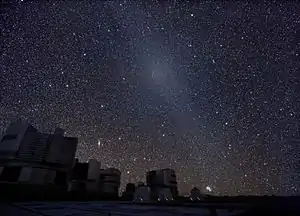Gegenschein
Gegenschein (/ˈɡeɪɡənˌʃaɪn/; German: [ˈɡeːɡənʃaɪn]; lit. 'countershine') is a faintly bright spot in the night sky centered at the antisolar point. The backscatter of sunlight by interplanetary dust causes this optical phenomenon, also called counterglow.

Explanation
Like zodiacal light, gegenschein is sunlight scattered by interplanetary dust. Most of this dust orbits the Sun near the ecliptic plane, with a possible concentration of particles centered at the L2 point of the Earth–Sun system.[1]
Gegenschein is distinguished from zodiacal light by its high angle of reflection of the incident sunlight on the dust particles. It forms a slightly brighter elliptical spot directly opposite the Sun within the dimmer band of zodiacal light. The intensity of the gegenschein is relatively enhanced because each dust particle is seen at full phase.[2]
History
The gegenschein was first described by the French Jesuit astronomer and professor Esprit Pézenas (1692–1776) in 1730. Further observations were made by the German explorer Alexander von Humboldt during his South American journey from 1799 to 1803. It was also Humboldt who gave the phenomenon its German name Gegenschein.[3]
The Danish astronomer Theodor Brorsen published the first thorough investigations of the gegenschein in 1854,[4] stating that Pezenas was the first to see it. T. W. Backhouse discovered it independently in 1876, as did Edward Emerson Barnard in 1882.[5] In modern times, the gegenschein is not visible in most inhabited regions of the world due to light pollution.
See also
- Antisolar point
- Earth's shadow
- Heiligenschein
- Interplanetary dust cloud
- Kordylewski cloud
- Opposition surge, the apparent brightening of a coarse surface or an aggregate of many particles when illuminated from directly behind the observer
- Sylvanshine
References
- Kopal, Zdeněk (June 14, 1962). "Communications on the Moon". New Scientist (291): 573.
- Levasseur-Regourd, Anny-Chantal; Hiroichi Hasegawa (1991). Origin and Evolution of Interplanetary Dust. International Astronomical Union Colloquium. p. 159. ISBN 0-7923-1365-8.
- Sheehan, William (1995). The immortal fire within: the life and work of Edward Emerson Barnard. Cambridge University Press. pp. 69–70. ISBN 0-521-44489-6.
- Moore, Patrick (2000). The Data Book of Astronomy. CRC Press. p. 490. ISBN 1-4200-3344-1.
- Ley, Willy (April 1961). "The Puzzle Called Gegenschein". For Your Information. Galaxy Science Fiction. pp. 74–84.
External links
| Look up gegenschein in Wiktionary, the free dictionary. |
- Gegenschein page on EarthSky.org
- Photos of gegenschein on SwissEduc.ch taken from Stromboli volcano
- "Zodiacal Light and the Gegenschein", an essay by J. E. Littleton
- NASA Astronomy Picture of the Day: The Gegenschein Over Chile (7 May 2008)
- Chisholm, Hugh, ed. (1911). . Encyclopædia Britannica (11th ed.). Cambridge University Press.
